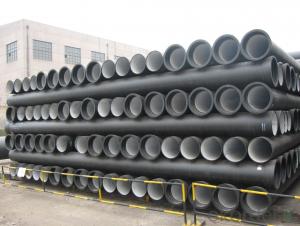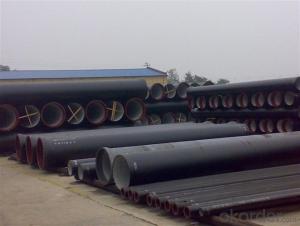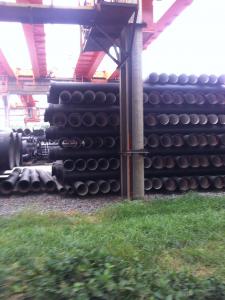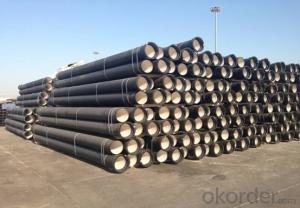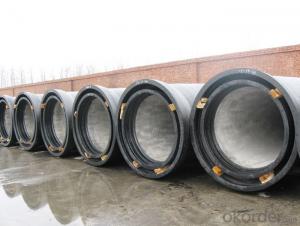DUCTILE IRON PIPES AND PIPE FITTINGS k9 CLASS DN1800
- Loading Port:
- Tianjin
- Payment Terms:
- TT OR LC
- Min Order Qty:
- 22 pc
- Supply Capability:
- 3000 pc/month
OKorder Service Pledge
OKorder Financial Service
You Might Also Like
Material : Ductile Cast Iron
Size Range : DN 80mm to DN 2000mm
Unit Effective Length : 6m or 5.7m
Manufacture Standard: ISO 2531:1998/ EN 545:2006/EN 598:2007
Annual capacity : 200,000 tons
Coating Exterior: Zinc 130g/m2 according to ISO 8179-1 and bitumen coating 70 microns.
Cement Interior: Portland Cement/ High Alumina Cement/ Sulphate Resisting Cement Lining according to ISO 4179
Special requirements on external coating and internal lining can be applied
We also provide accessories such as SBR/EPDM rubber gaskets, lubricant paste, pipe caps, PE sleeves, etc.
Additional Parts:
Each pipe is strictly inspected according to related standard to ensure permanently high performance.
Easy Installation at site and service free for life
Long Service Lifespan
Quotation will arrive you within 24hours once we get your inquiry.
We guarantee offering you a competitive price.
A copy of original inspection reports of pipes will be offered after shipment.
Photos of loading process will be sent to the customer after shipment effect.
We will follow-up the delivery progress after shipment effect and update to the customer on weekly basis.
- Q: How does ductile iron pipe perform in high-temperature environments?
- Due to its unique properties and characteristics, ductile iron pipe performs exceptionally well in high-temperature environments. It is known for its high strength, toughness, and durability, making it suitable for various applications that involve elevated temperatures. One of the main advantages of ductile iron pipe in high-temperature environments is its ability to withstand thermal expansion and contraction. With a low coefficient of thermal expansion, the material can handle significant temperature fluctuations without suffering detrimental effects. This ensures that the pipe remains structurally stable, avoiding deformation or cracking when exposed to high temperatures. Moreover, ductile iron pipe exhibits excellent thermal conductivity, allowing it to efficiently transfer heat. This prevents the accumulation of excessive heat and reduces the risk of thermal stress. Additionally, its high thermal conductivity enables it to dissipate heat quickly, ensuring that the pipe remains within safe operating temperatures. Furthermore, ductile iron pipe has a high melting point of approximately 2200°F (1200°C). This characteristic guarantees that the pipe maintains its structural integrity even in extremely high-temperature environments, making it capable of effectively handling hot fluids, steam, and other substances at elevated temperatures without compromising performance. Another crucial aspect is the corrosion resistance of ductile iron pipe. It is commonly coated with protective linings, such as cement mortar or epoxy, which act as a barrier against corrosion caused by high temperatures. These linings prevent direct contact between the pipe and corrosive substances, thereby ensuring the pipe's longevity in high-temperature environments. In conclusion, ductile iron pipe is an excellent choice for high-temperature environments due to its exceptional strength, thermal stability, thermal conductivity, and corrosion resistance. Its ability to withstand thermal expansion, high melting point, and efficient heat transfer properties make it a reliable and durable option for various applications in such conditions.
- Q: Are ductile iron pipes resistant to hydrostatic pressure?
- Yes, ductile iron pipes are resistant to hydrostatic pressure. Ductile iron is a type of cast iron that is known for its strength and durability. It has excellent mechanical properties, including high tensile strength and elasticity, which enable it to withstand high levels of hydrostatic pressure. This makes ductile iron pipes well-suited for applications where water or other fluids need to be transported under pressure, such as in water distribution systems, sewer lines, and industrial pipelines. Additionally, ductile iron pipes have a high resistance to corrosion, which further enhances their ability to withstand hydrostatic pressure and ensures their long-term performance and reliability.
- Q: It's not easy to drill ductile iron with cobalt high speed steel bit. Please help to point it out
- The material can be annealed and the process is simple, that is, heating the workpiece and cooling it naturally. In this way, the hardness of the workpiece can be reduced.
- Q: What is the expected fire resistance of ductile iron pipes?
- The fire resistance of ductile iron pipes can vary based on factors such as pipe wall thickness, installation quality, and surrounding conditions. However, in general, ductile iron pipes exhibit high fire resistance due to their durable and heat-resistant composition. Ductile iron is created by adding a small amount of magnesium to cast iron, which enhances its strength and flexibility. This results in ductile iron pipes being less prone to cracking or breaking under high temperatures compared to materials like PVC or HDPE pipes. Regarding fire resistance, ductile iron pipes can endure high temperatures for a prolonged period without significant structural damage. They have undergone testing and have been proven to maintain their integrity in fire situations for 2-4 hours, depending on the specific pipe design and installation. It is important to note that while ductile iron pipes possess high fire resistance, they are not fireproof. In the event of a fire, it is vital to adhere to proper fire safety procedures and seek advice from professionals to ensure the safety of the system and surrounding infrastructure.
- Q: How do ductile iron pipes handle extreme temperatures?
- Ductile iron pipes, known also as cast iron pipes, possess the ability to effectively handle extreme temperatures. The material composition of ductile iron enables it to endure both high and low temperatures without experiencing significant damage or degradation. When exposed to high temperatures, ductile iron pipes demonstrate exceptional thermal resistance, rendering them suitable for applications involving the transportation of hot liquids or gases. The high melting point of ductile iron, ranging from 2060°C to 2200°C, guarantees that the pipes can withstand extreme heat without melting or distorting. Consequently, these pipes are ideal for utilization in industries such as oil and gas, steam distribution, and high-temperature water supply systems. Likewise, ductile iron pipes exhibit satisfactory performance in low-temperature environments. They possess a low coefficient of thermal expansion, thereby enabling them to endure the expansion and contraction that occurs during temperature fluctuations without cracking or fracturing. This quality makes them appropriate for use in cold climates or in applications involving the transportation of chilled liquids or gases. Furthermore, ductile iron pipes possess excellent thermal conductivity, allowing them to efficiently dissipate heat. This characteristic proves particularly significant in high-temperature applications where effective heat transfer is vital to prevent damage to the pipes or the materials being transported. In conclusion, ductile iron pipes effectively handle extreme temperatures due to their high melting point, low coefficient of thermal expansion, and exceptional thermal conductivity. These attributes establish them as a dependable choice for various applications involving extreme temperature conditions.
- Q: What are the advantages of cast iron pipes?
- The ductile iron pipe with flexible joint construction, convenient operation, can improve the efficiency of construction, improve the construction conditions, reduce the construction cost, and most of the rubber ring connection interface, simple operation, can shorten the construction period, reduce the construction cost.
- Q: Are ductile iron pipes suitable for use in hydropower projects?
- Indeed, ductile iron pipes prove to be a suitable option for implementation in hydropower projects. Possessing a remarkable tensile strength and corrosion resistance, these pipes emerge as the ideal choice for applications in hydropower projects where water flow and pressure play a significant role. Demonstrating the ability to endure high pressure and boasting durability, these pipes guarantee long-term reliability and safety within hydropower systems. Furthermore, when compared to alternative materials such as steel, ductile iron pipes present a cost-effective solution, rendering them a favored selection for hydropower projects. In summary, ductile iron pipes possess the essential characteristics and performance qualities necessary to meet the rigorous conditions encountered in hydropower projects.
- Q: What is the expected corrosion protection system for ductile iron pipes?
- The expected corrosion protection system for ductile iron pipes typically involves a combination of external coatings, internal linings, and cathodic protection. External coatings are applied to the exterior surface of the pipe to provide a barrier against corrosion. These coatings are typically made of fusion-bonded epoxy, polyethylene, or polyurethane. They protect the pipe from the surrounding environment, including soil, water, and chemicals, and help to extend the lifespan of the pipe. Internal linings are applied to the interior surface of the pipe to protect against corrosion from the transported fluid. These linings can be made of cement mortar, epoxy, or polyurethane. They provide a smooth and protective layer, preventing the formation of rust and scale on the pipe's inner surface. Cathodic protection is an electrochemical technique used to protect ductile iron pipes from corrosion. It involves the use of sacrificial anodes or impressed current systems to create a protective electrical current that counteracts the corrosion process. This method helps to prevent the formation of rust and extends the life of the pipe. It is important to note that the specific corrosion protection system for ductile iron pipes may vary depending on the application and environmental factors. Consulting with corrosion experts and adhering to industry standards and guidelines is crucial in determining the appropriate corrosion protection system for a particular ductile iron pipe installation.
- Q: Ductile iron pipes lined with cement mortar in the water (living water, water in the 6.9-7.3) in the early pH, why pH increased? How to solve this problem?
- 1, because of the bone in mortar, such as silicate products, there will be silicification reaction, in addition, there is the reaction of limestone in lime.2, cement mortar lining cover coating, that is, spray some paint! Some questions four are unavoidable
- Q: Are ductile iron pipes suitable for underground parking structures?
- Underground parking structures can benefit from the use of ductile iron pipes. These pipes are recognized for their robustness and long-lasting nature, making them an optimal option for underground settings where they may encounter substantial loads or potential impacts. Moreover, ductile iron pipes exhibit exceptional resistance to corrosion, a crucial characteristic in underground environments that are prone to moisture and other corrosive elements. Furthermore, the high tensile strength and flexibility of ductile iron pipes enable them to withstand ground movements and settle without any cracking or breaking, further elevating their suitability for underground parking structures. In sum, ductile iron pipes offer a dependable and enduring solution for fulfilling the drainage and water supply requirements of underground parking facilities.
Send your message to us
DUCTILE IRON PIPES AND PIPE FITTINGS k9 CLASS DN1800
- Loading Port:
- Tianjin
- Payment Terms:
- TT OR LC
- Min Order Qty:
- 22 pc
- Supply Capability:
- 3000 pc/month
OKorder Service Pledge
OKorder Financial Service
Similar products
Hot products
Hot Searches
Related keywords









